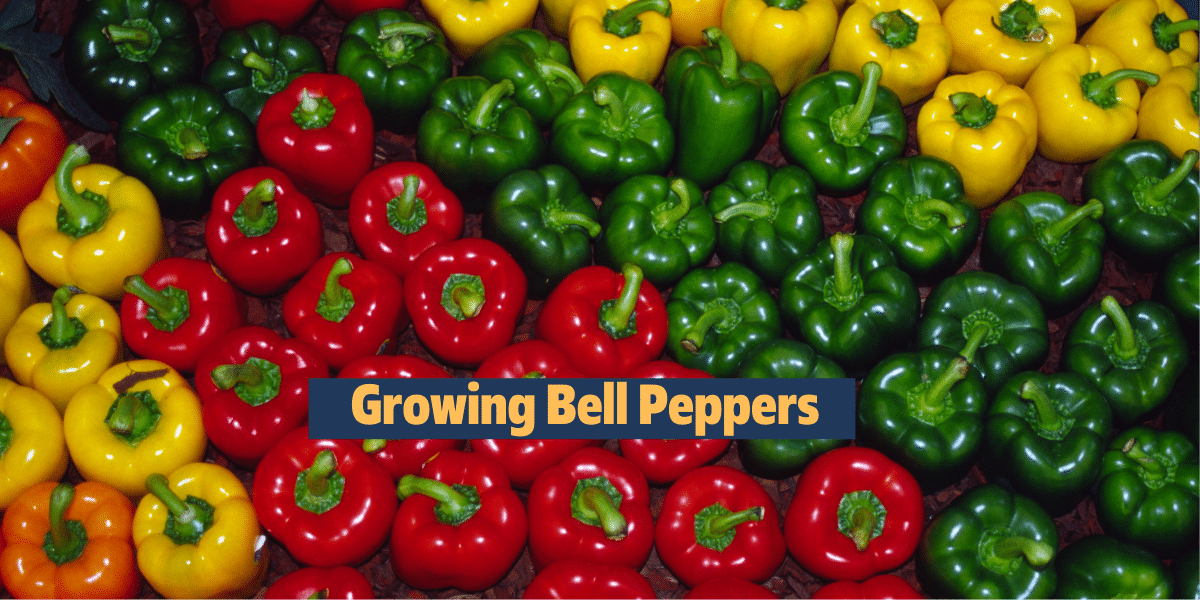Planting, Growing and harvesting bell peppers info
Planting, Growing and harvesting bell peppers, (Capsicum annuum) are natural products that have a place with the nightshade family. They are identified with stew peppers, tomatoes, and breadfruit, all local to Central and South America. Additionally called sweet peppers or capsicums, chime peppers can be eaten either crude or cook. Like their direct relations, bean stew peppers, ringer peppers are now and again dried and powdered.
Peppers oppose most nursery irritations and offer something for everybody: fiery, sweet, or hot; and various tones, shapes, and sizes. On this page, we center around Growing bell peppers. In contrast to their hot brethren, chime peppers don’t contain capsaicin, which is the compound that grows hot peppers, for example, jalapeño peppers, their sharpness, and warmth. Let’s come down next to know more about how to plant, grow and harvest bell peppers.
Table Of Content
An Overview Of Bell peppers
Biological Name
Capsicum annuum
Plant Type
Vegetable
Maturity Period
60 to 90 days
Maturity Size
18 to 24 cms
Soil Type
sandy and loamy
Soil pH
5.8 to 6.5
Exposure
Sunny
Hardiness (USDA Zone)
4, 5, 6, 7, 8, 9, 10, 11
Spacing
46 cm in between each plant
Bloom Time
Summer
Toxicity
Non-Toxic
Flower Color
White
Growth Rate
1.5- 2 months
Native Zone
Mexico, Central America, and northern South America
Maintenance
Keep bell peppers all around watered, however never leave soil saturated. Water to saturate the soil around 6 inches down, at that point let it dry somewhat. Watering is particularly significant during organic product sets when small peppers replace blooms, and as the chimes develop.
History of bell peppers
Bell peppers plant began in Mexico, Central America, and South America. Peppers were titled by Christopher Columbus and Spanish adventurers who were looking for peppercorn plants to create dark pepper. Columbus took tests of a wide assortment of peppers back to Europe, where they became very well known. From that point forward, Bell pepper seeds have moreover been acquainted with Africa and Asia. Peppers are utilized as a portion of food, topping, and zest.
Today, most Pepper plants were selling in the United States are filled in Florida. California, Texas, New Jersey, and North Carolina likewise give a part of peppers sold in stores. Wisconsin-developed ringer peppers are accessible at rancher’s markets for a restricted time frame during July, August, and September.
Planting Bell peppers
When To Plant Growing Bell peppers
- Peppers are a delicate, warm-season crop, so they commonly should be begun inside whenever developed from seed. Start seeds inside 8-10 weeks before your previous spring ice date.
- Ringer peppers require a genuinely long developing season (60 to 90 days), which is another motivation to begin them inside: they get a decent head-start!
- On the off chance that developing from nursery-purchased transfers, plant them outside 2 to 3 weeks after the danger of ice has passed. Make sure to solidify young plants before planting outside, as peppers are exceptionally delicate to cool temperatures.
Where To Grow Beets
- Pepper plants require full sun to create the biggest and best natural product, so pick a site that will not get concealed by trees or other nursery plants.
- The soil ought to be well-depleting and wealthy in natural matter. Peppers don’t prefer to have “wet feet,” so try not to plant them in areas that get excessively wet.
- A dirt consistency somewhere close to sandy and loamy guarantees that the dirt depletes well and warms rapidly.
- Soil pH ought to be on the somewhat acidic side—6.0 to 7.0, in a perfect world.
- Seven days before relocating peppers into the nursery, bring manure or matured fertilizer into your nursery soil. On the other hand, blend in a sluggish delivery compost.
- Try not to plant peppers in where you’ve as of late developed different individuals from the nightshade family—like tomatoes, potatoes, or eggplants—as this can open peppers to sickness.
Growing Of Bell Peppers
The soil ought to be well depleting. However, make certain to keep up satisfactory dampness either with mulch or plastic covering. Peruse more about utilizing mulch.
Water one to two inches for every square foot each week, yet recollect that sweet peppers are very delicate. Green bell pepper plants are additionally defenseless to bloom end decay if watering isn’t sufficient. On the off chance that you live in a warm or desert environment or are essentially encountering a blistering, dry summer, watering regular might be vital.
Prepare with low-nitrogen manure after the leading natural product set. (An excess of nitrogen can make the plant produce foliage rather than blossoms and organic product!)
Weed cautiously around plants to try not to upset roots.
On the off chance that is important, support plants with pens or stakes to forestall bowing. Attempt economically accessible cone-molded wire tomato confines.
Growing Green Bell peppers in pots
- Peppers have decently enormous root frameworks, so the holders should be at any rate 14 inches down; the more profound, the better as far as efficiency. Bell pepper sprouts (short of what one foot high) fill well in two-gallon holders, yet more excellent plants need at any rate five-gallon pots.
- You can develop peppers in a compartment as long as it’s large enough and has excellent waste. You can bore openings if your compartment doesn’t, as of now, have them—cover seepage openings with a lattice to keep soil in and bothers out. A few cultivators put a layer of rock on top of the cross-section. Try not to set your pot in a saucer or external holder without seepage, or you’ll invalidate the point of the openings.
- Bell pepper plants assortments with pendulous propensities, similar to Lemon Drop, make alluring and beneficial hanging containers. You may even attempt a portion of the more modest assortments in window boxes.
Harvest Growing Bell Peppers
Harvesting Bell peppers in a Raised Bed
As the plants develop, the chime peppers will require less water. Throughout the late spring months, watering the vegetables two times per week, considering a decent splashing, is, for the most part, adequate.
Growing red bell peppers filling in a nursery
Prepare consistently and add natural corrections to the dirt.
Your vegetables may stand as they become more extensive. They are backing the development of Planting pepper seeds by encasing the plants in tomato confines or giving them stakes.
Investigate pepper plants frequently to eliminate any wrecked branches.
Harvest Growing Bell Peppers in Other Methods
Pruning
As a matter of first importance, we should clarify two different ways of pruning chime peppers. The main route for pruning pepper plants is early season pruning, and the second is late season pruning. We will take a gander at the advantages of both of these.
Early Season Pepper Plant Pruning
When it comes to bell peppers, pruning toward the start of the period, before the plant has set organic product, is assumed to help increment yield. The hypothesis goes that the expanded air course and better access of daylight to the more profound pieces of the plant will assist it with developing more peppers. In college examines, this sort of ringer pepper pruning entirely diminished the number of organic products on the plant. Thus, the hypothesis that doing this will expand the number of organic products is bogus.
Step by step instructions to Prune Peppers Early in the Season Early season
Pepper plant pruning shouldn’t be done until the Pepper plant spacing is (31 cm.) tall and can be halted whenever natural products have been set. Most pepper plants have an in general ‘Y’ shape, and branches at that point make more modest and more modest Y’s off of the primary stems. When the plant is afoot (31 cm.) tall, you will want to see the most grounded branches on the plant. Scale back any more modest branches, including any suckers. Suckers are branches developing from the convict where two different branches structure a ‘Y.
Late Season Pepper Plant Pruning
The fundamental motivation to prune peppers late in the season is to accelerate developing the organic products that are ledge on the plant. Pruning chime peppers late in the season assist with accelerating the maturing interaction since it zeros in the plant’s energy on the leftover organic product.
Harvest Growing bell peppers for canning
Collect when peppers arrive at the wanted size or shading.
The more drawn-out ringer peppers stay on the plant, the sweeter they become and the more prominent their nutrient C substance.
Utilize a sharp blade or scissors to cut peppers clear off the plant.
Capsicum plants can be chilled in plastic packs for as long as ten days after collecting.
Ringer peppers can be dried, and we would suggest an ordinary broiler for the assignment:
Wash, center, and seed the peppers. Cut into one-half-inch strips. Steam for around ten minutes, at that point, spread on a heating sheet. Dry in the broiler at 140°F (or the most reduced conceivable temperature) until fragile, mixing at times and exchanging plate positions. At the point when the peppers are cool, put them in sacks or capacity holders.
Caring Of Growing Peppers
Contingent upon your environment, peppers may incline toward halfway shade, morning sun, or full sun. They need warmth yet can get overheat in humid environments. One extraordinary advantage of cultivating in compartments is that you can move your plants to better conditions on a case-by-case basis. Pepper seedlings need to be properly cared for.
Dry soil is sad for peppers; it will moderate or even stop creation. Your test will be to keep the dirt equally clammy yet not wet. Mulching will help hold soil dampness and hold weeds down.
Beginning from the get-go in the developing season, prepare with a feeble arrangement of good fluid manure, a period discharge compost, or fish emulsion. An excess of nitrogen will make plants with rich foliage and few peppers.
Key an eye out for aphids and insect scarabs. On the off chance that you smoke or handle tobacco, wash your hands before contacting the pepper plants since peppers are defenseless against the tobacco mosaic infection.
Caring Tips During Plantation
Days to development will, in general, be somewhere in the range of 55 and 70 for most assortments.
Reap roots when golf-ball-size or bigger; exceptionally enormous roots might be intense and woody.
Release the dirt around the beet and tenderly draw it from the earth.
Reap the beet greens at practically any time, starting when diminishing seedlings.
Pests And Disease
Several insects are on the plants, Pepper plant care is important and we need to make sure to use pest control. Insects can bring any diseases, and by having some pest control, we make sure that it is safe to eat the vegetable. Some of the diseases and insects are listed below:
Anthracnose (Type of Fungus)
Aphids (Type of insects)
Blossom-end Rot (nutrient and deficiency)
Colorado Potato Beetles (Type of Insect)
Mosaic Virus
FAQ
Will Bell Peppers ripen off the vine?
Do bell peppers plants need a trellis?
Are bell peppers fruits?
Are bell peppers perennial?
How big should a bell pepper be before picking?

